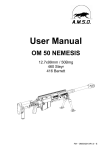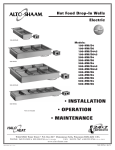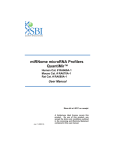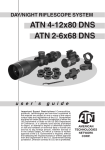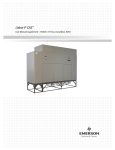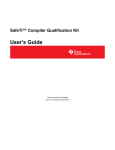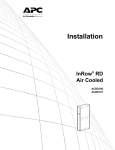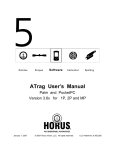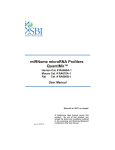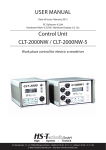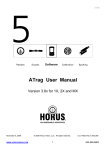Download User manual - Swiss Arms
Transcript
SAN 511 User Manual Models: SAN 511 SAN 511-1 SAN 511-2 Document Nr: 40 425 034 Edition: 04.2011 SAN 511 TABLE OF CONTENTS Chapter Subject (s) Safety warnings Page Number 4 Safety rules Clearing the weapon Blast effect safety rules 15 15 16 A Introduction 17 B Technical information 19 C C.1. C.2. C.3. Models & variants SAN 511 SAN 511-1 SAN 511-2 20 20 20 D D.1. D.2. D.3. D.4. D.5. D.6. D.7. Standard equipment 5rds box mag. & manual feeding block Field cleaning kit Bolt tool MilDial carrying case, Negrini 1640 wrench set, PB 211H6 Scope ring set, (Ø30, 34, 35) 21 21 22 22 22 22 22 E E.1 E.2 E.3 E.4 E.5 E.6 E.7 E.8 E.9 E.10 E.11 E.12 E.13 E.14 E.15. E.16. Accessories, basic spare parts & tools Armory, bolt tool Armory, bolt head repair kit Armory, cleaning kit Armory, gauges kits Broken case / shell extractor X-tra large bipod skids kit Field, firing pin kit Saddle / top rail kit with low saddle rail Saddle rail, raised Top rail, long Top rail, short Side rail short, low or raised Side rail long, low or raised Slings Stuck case / shell extractor Sound suppressor 23 23 23 24 25 25 25 25 26 26 26 26 26 27 27 27 1 1.1. 1.2. Weapon setup Bolt storing setup Bolt check 28 28 2. 3. Arming the firing pin Bolt lubrication 29 31 2 - 82 SAN 511 Chapter Subject (s) 4. Firing pin and shroud removal 33 5. Bolt insertion 36 6. Stock setup 39 7. Loading the magazine 41 8. Loading the rifle 42 9. Unloading the rifle 44 10. Barrel change, switch or removal 45 11. 11.1. 11.3. Muzzle brake & suppressor Muzzle brake removal Suppressor assembly 50 51 12. Stock length adjustment 53 13. Stock comb high adjustment 54 14. Ground spike adjustment 55 15. Bipod adjustment 56 16. 16.1. 16.2. 16.3. 16.4. Preventive maintenance procedures General maintenance Specific maintenance Rifle cleaning schedules Component service / replacement intervals 59 60 61 61 17. Troubleshooting 62 18. Broken shell extractor 63 19. Stuck case extractor 68 20. Mildial 70 21. 21.1. Zeroing the rifle Zeroing target 78 79 22. Limited warranty 80 23. Limitation of warranty 80 3 - 82 Page Number SAN 511 1 Safety warnings SAN 511 PRECISION RIFLE 12.7 x 99 mm (.50 BMG) 1.1 Handling The safety warnings in this booklet are important. By understanding the dangers inherent in the use of any firearm, and by taking the precautions described herein, you can enjoy complete safety in the use of your Rifle. Failure to heed any of these warnings may result in serious injury to you or others, as well as severe damage to the firearm or other property. 1.1.1 Dangerous Weapons PISTOLS, REVOLVERS, SHOTGUNS and RIFLES are classified as FIREARMS or DANGEROUS WEAPONS and are sold by us with the specific understanding that we are not responsible in any manner whatsoever for their safe handling or resale under local laws and regulations. SAN Swiss Arms AG shall not be responsible in any manner whatsoever for malfunctioning of the firearm, for physical injury or for property damage resulting in whole or in part from (1) criminal or negligent discharge, (2) improper or careless handling, (3) unauthorized modifications, (4) defective, improper, hand-loaded, or reloaded ammunition, (5) corrosion, (6) neglect, or (7) other influences beyond our direct and immediate control. This limitation applies regardless of whether liability is asserted on the basis of contract, negligence or strict liability (including any failure to warn). Under no circumstance shall SAN Swiss Arms AG be liable for incidental or consequential damages, such as loss of use of property, commercial loss and loss of earnings or profits. 1.1.2 15 commandments of firearms safety 1. ALWAYS carry the rifle loaded with the safety lever in the SAFE position. 2. Keep the safety lever on SAFE unless actually firing. 3. ALWAYS treat every gun as if it were loaded. 4. ALWAYS be sure the barrel is clear of any obstruction. 4 - 82 SAN 511 5. ALWAYS be sure of your backstop, what lies beyond and the safety of bystanders before you shoot. 6. ALWAYS use clean, dry, original factory-made ammunition of the proper type and caliber for your gun. 7. ALWAYS wear ear protection and safety glasses when shooting. 8. ALWAYS carry your gun so that you can control the direction of the muzzle if you fall or stumble. 9. NEVER shoot at a flat surface or water. 10. DO NOT leave an unattended gun loaded. Guns and ammunition should be stored separately, locked if possible, beyond the reach of children and careless adults. 11. NEVER allow your firearm to be used by anyone who has not read and understood this instruction and safety manual. 12. DO NOT point any gun, loaded or unloaded, at any undesired target. 13. NEVER fire your rifle near an animal unless it is trained to accept the noise: an animal’s startled reaction could injure it or cause an accident. 14. NEVER drink alcoholic beverages or take drugs before or during shooting, as your vision and judgment could be seriously impaired making your gun handling unsafe. 15. ALWAYS seek a doctor’s advice if you are taking medication, to be sure you are fit to shoot and handle your rifle safely. 1.1.3 Protect your eyes and ears Always wear adequate safety glasses and ear plugs or «earmuff» type protectors whenever you are shooting. Always make certain that persons close to you are similarly protected. Unprotected eyes may be injured by powder gas, carbon residue, lubricant, metallic particles or similar debris which may emanate occasionally from any firearm in normal use. Without ear protection, repeated exposure to shooting noise may lead to cumulative, permanent hearing loss. 5 - 82 SAN 511 1.1.4 Ammunition 1. Use only high quality, original factory- manufactured ammunition. Do not use cartridges that are dirty, wet, corroded, bent, or damaged. Do not oil cartridges. Do not spray aerosol-type lubricants, preservatives, or cleaners directly onto cartridges or where excess spray may flow into contact with cartridges. Lubricant or other foreign matter on cartridges can cause potentially dangerous ammunition malfunctions. Use only ammunition of the caliber for which your firearm is chambered. The proper caliber is permanently engraved on your firearm; never attempt to use ammunition of any other caliber. 2. The use of reloaded, «remanufactured», hand-loaded, or other nonstandard ammunition voids all warranties. Reloading is a science and improperly loaded ammunition can be extremely dangerous. Severe damage to the firearm and serious injury to the shooter or to others may result. 3. Always use ammunition that complies with the industry performance standards established by the Sporting Arms and Ammunition Manufacturers’ Institute, Inc. of the United States (SAAMI). 4. Firearms may be severely damaged and serious injury to the shooter or to others may result from any condition causing excessive pressure inside the chamber or barrel during firing. Excessive pressure can be caused by obstructions in the barrel, propellant powder overloads, or by the use of incorrect cartridges or defectively assembled cartridges. In addition, the use of a dirty, corroded, or damaged cartridge can lead to a burst cartridge case and consequent damage to the firearm and personal injury from the sudden escape of high-pressure propellant gas within the firearm’s mechanism. Immediately stop shooting and check the barrel for a possible obstruction whenever: you have difficulty in, or feel unusual resistance in, chambering a cartridge, or; a cartridge misfires (does not go off), or; the mechanism fails to extract a fired cartridge case, or; 6 - 82 SAN 511 unburned grains of propellant powder are discovered spilled in the mechanism, or; a shot sounds weak or abnormal. In such cases it is possible that a bullet is lodged part way down the barrel. Firing a subsequent bullet into the obstructed barrel can wreck the firearm and cause serious injury to the shooter or to bystanders. 5. Bullets can become lodged in the barrel: if the cartridge has been improperly loaded without propellant powder, or if the powder fails to ignite, (ignition of the cartridge primer alone will push the bullet out of the cartridge case, but usually does not generate sufficient energy to expel the bullet completely from the barrel), or; if the bullet is not properly seated tightly in the cartridge case. When such a cartridge is extracted from the chamber without being fired, the bullet may be left behind in the bore at the point where the rifling begins. Subsequent chambering of another cartridge may push the first bullet further into the bore. 6. If there is any reason to suspect that a bullet is obstructing the barrel, immediately unload the firearm and look through the bore. It is not sufficient to merely look in the chamber. A bullet may be lodged some distance down the barrel where it cannot easily be seen. IF A BULLET IS IN THE BORE, DO NOT ATTEMPT TO SHOOT IT OUT BY USING ANOTHER CARTRIDGE, OR BY BLOWING IT OUT WITH A BLANK OR ONE FROM WHICH THE BULLET HAS BEEN REMOVED: SUCH TECHNIQUES CAN GENERATE EXCESSIVE PRESSURE, WRECK THE FIREARM AND CAUSE SERIOUS PERSONAL INJURY. If the bullet can be removed with a cleaning rod, clean any unburned powder grains from the bore, chamber, and mechanism before resuming shooting. If the bullet cannot be dislodged by tapping it with a cleaning rod, take the firearm to a gunsmith. 7. Dirt, corrosion, or other foreign matter on a cartridge can impede complete chambering and may cause the cartridge case to burst 7 - 82 SAN 511 upon firing. The same is true of cartridges which are damaged or deformed. 8. Do not oil cartridges, and be sure to wipe the chamber clean of any oil or preservative before starting to shoot. Oil interferes with the friction between cartridge case and chamber wall that is necessary for safe functioning, and subjects the firearm to stress similar to that imposed by excessive pressure. 9. Use lubricants sparingly on the moving parts of your firearm. Avoid excessive spraying of any aerosol gun care product, especially where it may get on ammunition. All lubricants and aerosol spray lubricants in particular can penetrate cartridge primers and cause misfires. Some highly penetrative lubricants can also migrate inside cartridge cases and cause deterioration of the propellant powder; on firing, the powder may not ignite. If only the primer ignites, there is danger that the bullet may become lodged in the barrel. 1.1.5 NEVER completely trust any safety 1. Your firearm comes equipped with an effective, well-designed safety device: HOWEVER, NEVER RELY COMPLETELY ON ANY SAFETY MECHANISM. It is NOT a substitute for cautious gun handling. NO safety, however positive or well-designed, should be totally trusted. Like all mechanical devices, the safety is subject to breakage or malfunction and can be adversely affected by wear, abuse, dirt, corrosion, incorrect assembly, improper adjustment or repair, or lack of maintenance. Moreover, there is no such thing as a safety which is «child-proof» or which can completely prevent accidental discharge from improper usage, carelessness, or «horseplay». The best safety mechanism is your own good sense; USE IT! Always handle your firearm as though you expect the safety NOT to work! 2. While handling any firearm, do not allow it to point at any part of your body or at another person. No harm will result if you obey this rule, even if an accidental discharge occurs. 8 - 82 SAN 511 3. Never carry this rifle with a cartridge in the chamber and the trigger cocked. 4. Always keep your finger off the trigger and point the muzzle in a safe direction when operating the gun. 1.1.6 Loading 1. Always make sure the muzzle is pointed in a safe direction! 2. Never attempt to load or unload any firearm inside a vehicle, building or other confined space (except a properly constructed shooting range). Enclosed areas frequently offer no completely safe direction to point the firearm; if an accidental discharge occurs, there is great risk of injury or property damage. 3. Before loading, always clean all grease and oil from the bore and chamber, and check to be certain that no obstruction is in the barrel. Any foreign matter in the barrel could result in a bulged or burst barrel or other damage to the firearm, and could cause serious injury to the shooter or to others. 9 - 82 SAN 511 1.1.7 Firing 1. Keep the muzzle pointed in a safe direction and your finger away from the trigger when cocking any firearm. 2. Never carry about or leave unattended any firearm which is cocked and ready to fire! When cocked, it will fire from slight pressure on the trigger. An accidental discharge could easily result if you fall or drop the firearm, or if the firearm is struck or disturbed by someone or something. 3. Never fire any firearm with your finger, hand, face, or other part of your body over or adjacent to the ejection port, or in any position where you may be struck by reciprocating movement of the breech. Both the ejection of empty cartridge cases and the movement of the breech are part of the normal operating cycle of firearms, and pose no safety hazard to the shooter if the firearm is held in a normal grip and fired at arm’s length. 4. Never allow other persons to stand beside you where they might be struck by an ejected cartridge case. The case is hot, and may be ejected with sufficient force to cause a burn or cut or injure an unprotected eye. Make certain there is a clear, unobstructed path for safe ejection of the fired case. Remember, the case may bounce off a hard object nearby and strike you or someone else. If, while shooting, your firearm develops a mechanical malfunction or binding, or «spits» powder gas, or if a cartridge primer is punctured or a cartridge case is bulged or ruptured, or if the report on firing does not sound quite right, STOP SHOOTING IMMEDIATELY! It may be dangerous to continue. UNLOAD THE FIREARM – do NOT try «one more shot». Take the firearm and the ammunition to a gunsmith for examination. 5. While shooting any firearm, an unfired cartridge or fired cartridge case may occasionally become jammed between the slide and the barrel. Clear the jam as follows, WHILE KEEPING THE MUZZLE POINTED IN A SAFE DIRECTION: Remove the magazine, then pull back the slide and lock it to the rear by pushing up the slide release. 10 - 82 SAN 511 The jammed cartridge or case now can be removed by shaking it out or by picking it out with the fingers. 1.1.8 Unloading 6. Always make sure the muzzle is pointed in a safe direction! 7. Remember to clear the chamber after the magazine has been removed. 8. Never assume that any gun is unloaded until you have personally checked it! 9. After every shooting practice, make a final check to be certain the firearm is unloaded before leaving the range. 1.2 Transport and storage When transporting your firearm to and from shooting activities, keep it unloaded for your safety and for the safety of others. When storing your firearm, keep it separated from ammunition, under lock and key if possible, and out of the reach of children and other inexperienced or unauthorized persons. 1.3 Maintenance All firearms require periodic maintenance and inspection which may reveal a need for adjustment or repair. Have your firearm checked by a competent gunsmith annually even if it seems to be working well, since breakage, improper functioning or corrosion of some components may not be apparent from external examination. If you notice any mechanical malfunction, do NOT continue to use the firearm. UNLOAD the firearm and take it to a competent gunsmith immediately for a thorough examination. Similarly, if water, sand, or other foreign matter enters the internal mechanism, immediately dismantle the firearm for a complete and thorough cleaning. Failure to keep your firearm clean and in proper working order can lead to a potentially dangerous condition and an accident causing serious bodily injury or property damage may result. 11 - 82 SAN 511 1.4 Care and cleaning 1. Your firearm is delivered factory packaged and preserved with a light coating of protective grease and oils. Before loading make certain that all packing grease and oil has been cleaned from the bore and exposed mechanism. 2. Before you begin to disassemble your firearm for cleaning, always double-check to make sure it is unloaded! 3. After cleaning always check to be sure that no cleaning patch or other obstruction remains in the bore or chamber! 1.5 Parts Our Service Department maintains a full complement of replacement parts. Even though most gunsmiths have the knowledge, training and ability to make the necessary repairs to your firearm, the skill and workmanship of any particular gunsmith is totally beyond our control. Should your firearm ever require service, we strongly recommend that you return it to SAN Swiss Arms AG. Follow the instructions outlined below. Remember, unauthorized adjustments of parts replacement can void your warranty. A firearm is a precision instrument and some replacement parts will require individual fitting to ensure correct operation. A wrong part, improper fitting or incorrect mechanical adjustment may result in an unsafe condition or dangerous malfunction, damage to the firearm, or possible serious injury to the shooter or to others. IF ANY PART IS ORDERED WITHOUT RETURNING THE FIREARM TO SAN SWISS ARMS AG, the customer bears full responsibility for ensuring that the part supplied is correct for his particular firearm and is properly installed and fitted by a qualified gunsmith. SAN SWISS ARMS AG CANNOT BE RESPONSIBLE FOR THE FUNCTIONING OF ANY FIREARM IN WHICH REPLACEMENT PARTS ARE INSTALLED BY OTHERS. 12 - 82 SAN 511 SAN SWISS ARMS AG service policy Before shipment your firearm was carefully inspected and test fired in order to ensure that it conformed to our specifications and standards. Should your firearm require adjustment, repair or refinishing, we strongly recommend that you return it to SAN Swiss Arms AG for factory service. If there is any question regarding the performance of your firearm, please write to SAN Swiss Arms AG Service Department, fully describing all circumstances and conditions involved. If our Service Department makes the determination that your firearm requires factory service, you will be so advised and will be given instructions for the most expeditious handling of your shipment. Our Service Department will give your firearm a complete inspection, and evaluate the problem(s) specified in your letter. lf the work required is not covered under the terms of our «Limited Warranty» (a copy is enclosed with your firearm), you will receive an actual cost quotation, not an estimate. Any repair work must be authorized by you, and no work will be done without your express approval. To return any firearm to us for adjustment, repair or refinishing, please follow these suggestions to expedite service: 1. Only federally licensed dealers may ship handguns via mail. Handguns mailed by individuals are confiscated by the Post Office. 2. Federal law permits you to return your firearm to the manufacturer for service via common carriers or, if your firearm is a rifle or shotgun, by mail. However, state and local firearms laws vary greatly; you should consult your local prosecuting attorney regarding any restrictive laws in your jurisdiction regarding your shipment or receipt of firearms. With the above in mind, it is strongly recommended that any firearm sent to us for repair be sent through a federally licensed dealer. 3. All firearms must be shipped to us prepaid. WE WILL NOT ACCEPT COLLECT SHIPMENTS. 4. Firearms returned for repair should be addressed to: SAN Swiss Arms AG Industrieplatz 8212 Neuhausen am Rheinfall Switzerland 5. Be sure to enclose a letter stating serial number, caliber and barrel length of your firearm. Also state nature of trouble experienced or 13 - 82 SAN 511 work required. Merely stating «defective» or «repair as necessary» is inadequate information. Be specific and enclose copies of any previous correspondence. 6. FIREARMS MUST BE SHIPPED UNLOADED. 7. Double-check the chamber of your firearm before shipping. If firearms are sent to SAN Swiss Arms AG in a loaded condition, we are required by law to notify the Federal Authorities. 8. DO NOT include telescopic sights, custom stocks, slings, or other accessories with any firearm shipped to us. 14 - 82 SAN 511 SAFETY RULES Rule N°1 Treat every weapon as if it is loaded. Rule N°2 Never point a weapon at anything or anybody that you do not intend to harm or destroy or in a direction where an unintentional discharge may result in damage to property, injury or death. Rule N°3 Never place your finger into the trigger guard until you are ready to fire the weapon. Rule N°4 Be sure of your target and of what’s behind it before firing Rule N°5 Always wear eye & ear protection when firing a weapon. Rule N°6 Clear every weapon before handling it. CLEARING THE WEAPON A.) B.) C.) D.) E.) Rotate the safety lever to “SAFE” Open the bolt Remove the magazine Inspect the chamber for the presence of a live round or empty case Visually: look at the chamber through opened ejection port Physically: Insert index finger through ejection port to feel the presence of a round or empty case in the chamber. Empty live rounds from the magazine. Remove and store any live rounds and/or empty cases from whiting the weapon or magazine before handling the weapon further. 15 - 82 SAN 511 BLAST EFFECT SAFETY RULES To reduce the recoil felt by the shooter this rifle is equipped with a high efficiency muzzle brake. In order to reduce the recoil, a major part of the gases released when firing a round create a reverse thrust in the muzzle brake. This generates “THRUST ZONES”, also called “BLAST.” Avoid these zones while weapon is in use. Debris from the ground could be projected at high speed and could cause injuries to bystanders. Therefore, it is important to clear the surface of small objects prior to shooting. There should be a minimum of 2m between teams shooting in line. Shooting in closer position will place shooters in the Blast zone. When shooting as a team, the spotter must have his shoulders at the level of the shooter’s hips and be as close as possible to him to be in the SAFE ZONE. SHORT BARREL: TRUST PATTERN LONG BARREL: THRUST PATTERN 16 - 82 SAN 511 A.) INTRODUCTION A.1.) GENERAL INFORMATION PREPARATION FOR STORAGE OR SHIPMENT. Except in extreme situations, the rifle should always be stored and transported only in an airtight, watertight carrying case. RIFLE REPAIRS Rifles should only be repaired by SAN Swiss Arms AG or by a qualified professional, that has been approved by SAN Swiss Arms AG. If you must ship your weapon to be repaired remember to send the whole weapon assembly (not just the damaged part) and to use an airtight, waterproof carrying case as described above. A.2.) IDENTIFICATION OF MAJOR COMPONENTS (1) (2) (3) (4) (5) (6) (7) (8) (9) (10) (11) (12) (13) (14) (15) (16) (17) (18) (19) (20) (21) BARREL BIPOD BIPOD SKID PLATE BOLT BOLT STOP COMB FLUSH CUPS FOREND GROUND SPIKE MAG. CATCH LEVER MAGAZINE / MANUAL FEEDING BLOCK MUZZLE BRAKE PISTOL GRIP RECOIL PAD SADDLE RAIL SAFETY LEVER SIDE RAIL STOCK JOINT TOP RAIL TRIGGER SHOE UPPER RECEIVER 17 - 82 SAN 511 18 - 82 SAN 511 B.) SPECIFICATIONS Calibers 12.7x99mm Overall length, stock collapsed Overall length, stock fully extended Overall length, stock folded 50 Bmg 460 Steyr 416 Barrett 1338mm 1413mm 1092mm 52.7” 55.6” 43” 900mm 800mm 700mm 600mm 450mm 35.5” 31.5” 27.5” 23.5” 17.75 381mm 356mm 279mm 15” 14” 11” Barrels length (w/o muzzle brake) Twist 50Bmg 460 Steyr 416 Barrett Twist direction Nbr of lands & grooves Weight with 700mm / 27.5” barrel SAN 511 SAN 511-1 SAN 511-2 Right 6 11.4Kg 13.4Kg 13.8Kg B.1.) CAPABILITIES Ammunition type: Muzzle velocity: Energy: Effective range: Maximum range: 19 - 82 Standard M33 ammunition with 700mm / 27.5” barrel 850m/s – 2800 f/s 15250 joules approximately 1850m / 2000 yards approximately 6500m / 7000 yards 25Lbs 29.5Lbs 30.4Lbs SAN 511 C.) MODELS & VARIANTS C.1.) SAN 511 Fixed fully adj. stock, 700mm Barrel. 1x Field cleaning kit 1x Bolt tool 1x Manual feeding block 1x Negrini, 1640 carry case 1x PB 211H6, wrench set C.2.) SAN 511-1 Folding fully adj. stock, 700mm Barrel, Bipod & ground spike. 1x 5rds Box mag. 1x Field cleaning kit 1x Bolt tool 1x Manual feeding block 1x MilDial 1x Negrini, 1640 1x PB 211H6, wrench set C.3.) SAN 511-2 Folding fully adj. stock, 700mm Barrel, Bipod & ground spike, integral tapered rail. 2x 5rds Box mag. 1x Field cleaning kit 1x Bolt tool 1x Manual feeding block 1x MilDial 1x Negrini, 1640 1x PB 211H6, wrench set 1x Scope ring set (choice: Ø30, 34, 35) 20 - 82 SAN 511 D.) STANDARD EQUIPMENT’S Equipment may vary depending on purchased model D.1.) 5rds box mag. & manual feeding block D.2.) Field cleaning kit 21 - 82 SAN 511 D.3.) Bolt tool D.4.) MilDial cm 75 cm 70 cm 1m 95cm 90cm 85cm 60 cm 7 30° 20° 6 cm 50 E NG RA 1 MIL TA 90m 95m 100m 55 5 45cm 4.8 4.6 4.4 4.2 40cm 4 3.8 3.6 35cm 3.4 3.2 5 MILS RG ° 85m 25° 10° cm ET E IBL AC EL ED NC TA DIS 5 57 5m .5 m 6 62 0m .5 65 m 67 m .5 70 m 50 72.5 m ° 75 m 77.5m m 80m 40 ° 60 35° m 50 m .5 52 55 ° 45° 65 8 10 CIBLE TARGET 9 METRIC UNITS 80cm © 2007, COPYRIGHT A.M.S.D., GENEVA SWITZERLAND MILDOT DIAL 3 0.2 MIL 0.8 MIL 1. ALIGNER LA TAILLE DE LA CIBLE AVEC LA VALEUR MESUREE EN MILS ( MILDOT ) 2. LIRE LA DISTANCE DE LA CIBLE DANS LA FENETRE DE GAUCHE 2.6 2.4 1.7 1.6 1.4 1.3 cm 15 1 10cm D.5.) TAILLE DE LA CIBLE TARGET SIZE 1.1 PATENT PENDING P/N : MDEF-M MADE IN SWITZERLAND 1.2 MILS Carrying case, Negrini1640 Not Illustrated D.6.) Wrench set, PB 211H6 D.7.) Scope ring set (Ø30, 34, 35) Not Illustrated 22 - 82 25cm 2.2 1.9 2 1.8 USER INSTRUCTIONS 1. ALIGN TARGET SIZE WITH MEASURED MILS ( MILDOT ) VALUE 2. READ TARGET DISTANCE IN LEFT WINDOW 30cm 2.8 INSTRUCTIONS D' UTILISATION 20 cm SAN 511 E.) ACCESSORIES, BASIC SPARE PARTS & TOOLS E.1.) Armory, bolt tool E.2.) Armory, bolt head repair kit E.3.) Armory, cleaning kit 23 - 82 E.4.) Armory, gauges kits Bolt, head gauges Barrel, chamber gauges Barrel, Dial. 12.63mm to 12.72mm gauges Barrel, 12.9mm to 12.99mm rifling gauge SAN 511 E.5.) Broken case / shell extractor E.6.) X-tra large bipod skids kit E.7.) Field, firing pin kit E.8.) Saddle / top rail kit with low saddle rail. 25 - 82 SAN 511 E.9.) Saddle rail, raised. E.10.) Top rail, long. E.11.) Top rail, short. Top rails could be ordered either with 30Moa or 45Moa depression. 2 dots at rear = 30Moa 3 dots at rear = 45Moa E.12.) Side rail short, low or raised. E.13.) Side rail long, low or raised. 26 - 82 SAN 511 E.14.) Slings, NOT ILLUSTRATED a.) b.) c.) Biathlon type Standard single strap type Standard double strap type E.15.) Stuck case / shell extractor E.16.) Sound suppressor Dimensions Calibers Overall diameter Overall length Weapon length addition Weight Threads 27 - 82 12.7x99mm 50 Bmg 460 Steyr 416 Barrett 80mm 3.15” 513mm 20.2” 163mm 6.4” 2.74Kg 6Lbs M30x1.5 Left hand twist SAN 511 1.) WEAPON SETUP 1.1.) Bolt storing setup Fig 1. 1.2.) Bolt Check Prior to inserting the bolt in the rifle 1.2.1.) Check Extractor function 1.2.2.) Visually inspect firing pin for erosion or wear marks 1.2.3.) Check Ejector plunger function Fig 2. 28 - 82 SAN 511 2.) ARMING THE FIRING PIN Prior to inserting the bolt in the rifle firing pin must be armed 2.1.) Use either bolt tool or 3mm Hex wrench to proceed Fig 3. IMPORTANT NOTICE BOLT MUST BE STORED WITH FIRING PIN SPRING IN RELEASED STATE Weapon may fail to fire may result if not stored as per Fig. 1. If the bolt is not stored properly, firing pin spring will need to be replaced more frequently to ensure proper function. 29 - 82 SAN 511 2.2.) Rotate the firing pin shroud 60° clockwise Fig 4. 2.3.) Bolt is now set Fig 5. 30 - 82 SAN 511 3.) BOLT LUBRICATION Prior to inserting the bolt in the rifle 3.1.) Lubricate firing pin cam path Fig 6. 3.2.) Lubricate bolt lugs Fig 7. 31 - 82 SAN 511 3.3.) Lubricate guiding slot Fig 8. IMPORTANT NOTICE Grease must be used for bolt lubrication Bolt lubrication process must be repeated every 25 to 50 rounds, depending on weather and/or environmental conditions. 32 - 82 SAN 511 4.) FIRING PIN AND SHROUD REMOVAL 4.1.) Insert the 3mm Hex wrench through the shroud Fig 9. 4.2.) Rotate the assembly 90° counter clockwise Fig 10. 4.3.) Extract the assembly from the bold body Fig 11. 33 - 82 SAN 511 4.4.) Lubricate the contact surfaces with grease Fig 12. 4.5.) Insert the firing pin assembly back in the bolt body Fig 13. 34 - 82 SAN 511 4.6.) Push the assembly forward and rotate 90° clockwise Fig 14. 4.7.) Once the shroud is in the proper position, you should be able to extract the wrench without force Fig 15. 35 - 82 SAN 511 5.) BOLT INSERTION PRIOR TO INSERTION Safety lever MUST be set to either FIRE or SAFE, as per shown in fig. 16, prior to introducing the bolt into the receiver. Trying to insert the bolt by force with safety lever set to SAFE – BOLT LOCKED will permanently damage the trigger system and will void the warranty. Fig 16. 36 - 82 SAN 511 5.1.) To insert the bolt in the weapon: If the weapon is on a flat surface, a stand or a table: Pull down bipod legs for steady handling. If you are in the field: Hold weapon vertical while keeping muzzle brake on firm base to prevent barrel obstruction. To open the bipod: Squeeze both legs together and turn clockwise. Fig 17. 37 - 82 SAN 511 5.2.) Push the bolt in to the receiver, a slight up or down rotation of the bolt handle will help bolt stop to engage the guiding slot. Fig 18. 5.3.) Lock the bolt and dry fire to check proper function of trigger, fully open the bolt until the bolt stop engages and close the bolt again, either dry fire or set the rifle on safety. Fig 19. Your rifle is now ready for operation. 38 - 82 SAN 511 6.) STOCK SETUP 6.1.) To open the stock: Pull or push up the stock holding it as close as possible from stock joint and rotate counter clockwise, until it locks in position. Fig 20. 6.2.) To open the ground spike: Pull forward and rotate clockwise, until it’s locked in position. Fig 21. Ground spike must only be used in the vertical position when shooting on a flat surface and when used as a rear support. 39 - 82 SAN 511 6.3.) Using the ground spike for target follow-up The ground spike can be used at a 45° angle to shoot from shoulder to follow up moving target or from high grounds down. Fig 22. 40 - 82 SAN 511 7.) LOADING THE MAG 7.1.) To load the magazine: Push on both sides while introducing cartridges from the front to the back, repeat until desired amount of rounds is reached. Maximal magazine capacity: 5 rounds Fig 23. DO NOT LEAVE ROUNDS IN THE MAGAZINE FOR AN EXTENDED PERIOD OF TIME AS THIS MAY CAUSE THE SPRING TO LOSE TENSION LEADING TO MALFUNCTION. 41 - 82 SAN 511 8.) LOADING THE RIFLE 8.1.) To Load the rifle: Insert loaded magazine, front end first as shown Rotate clockwise until it locks Check if magazine is properly locked During magazine insertion Bolt can either be closed or opened. Fig 24. 8.2.) Loaded weapon handling. Fig 25. 42 - 82 SAN 511 8.3.) Removing the safety: From either “SAFE” or “SAFE BOLT LOCKED” Turn safety lever to “FIRE” as shown in Fig. 26 Remove safety only when in proper shooting position. Fig 26. SAN 511 Weapon system has a built–in passive safety measure. All the trigger parts are dynamically balanced to sustain a 6-axis drop with a live round in the chamber & safety lever on FIRE position. Nevertheless, an operator should not rely soley on the mechanical safety devices Use extreme caution while handling the weapon loaded or not. 43 - 82 SAN 511 9.) UNLOADING THE RIFLE 9.1.) To unload the rifle: Turn safety lever to “SAFE”. Open the bolt. Check if the chamber is empty. Push on Latch and pull down the magazine. Fig 27. 9.2.) Pull out the magazine from the rifle. Fig 28. 44 - 82 SAN 511 10.) BARREL CHANGE, SWITCH OR REMOVAL Prior to proceeding. Safety lever must be set on the SAFE position Check that rifle is properly unloaded Open the bolt & check if barrel chamber is empty visually & manually Barrel switch has to be made in a clean as possible environment 10.1.) To take the barrel of the receiver A.) Use a 6mm Hex wrench to unlock the five (5) screws on the right side of the rifle, once screws are running free rotate each of them one (1) turn to give enough play space. Fig 29. 45 - 82 SAN 511 B.) Use a 3mm Hex wrench to activate the inner pusher Rotate clockwise until resistance is encountered Rotate ½ to ¾ of a turn to free the barrel. Fig 30. C.) Slide out the barrel from the receiver Fig 31. Check all contact surfaces on the receiver & the barrel Action: Clean if required. If the rifle is to be stored w/o barrel: Action: Release the left side screw for long term storage. If bolt has to stay in the receiver during storage: Action: Close bolt while pressing on the trigger shoe 46 - 82 SAN 511 10.2.) Reassembly of the barrel: Hold the rifle in a vertical position. Insert barrel with locking ring notch toward top picatinny rail. Close the bolt to ensure proper positioning of the barrel. IMPORTANT NOTICE Bolt has to be opened prior to barrel insertion Fig 32. 47 - 82 Fig 33. SAN 511 A.) Unscrew the left pusher screw. In a “DOWN” to “UP” order turn the five (5) screws on the right side until resistance is felt on each on of them, then start applying torque to each screw, following the same “DOWN” to “UP“ order. Proper torque is reached when supplied 6mm Hex wrench starts bending 15 to 20 mm / 9/16” to 3/4”. Fig 34. 48 - 82 Fig 35. B.) Double check screw torque following order pattern. FAILURE TO COMPLY MAY RESULT IN POOR ACCURACY Fig 35. SAN 511 11.) MUZZLE BRAKE & SUPPRESSOR 11.1.) Muzzle brake removal: a.) Use supplied 4mm Hex. Wrench. Fig 36. b.) Unscrew both retaining screws on muzzle brake. Fig 37. c.) Unscrew muzzle brake counter-clockwise. Fig 38. d.) Turn until muzzle brake until it comes off freely. Fig 39. 50 - 82 SAN 511 11.2.) Prior to assembly of either muzzle brake or suppressor. Check both Ø and threads. Fig. 40 Threads must be kept clean. Lubricate with grease to avoid seizing. Fig 40. 11.3.) Suppressor assembly a.) Slide muzzle brake over barrel. Fig 41. b.) Until contact with threads is felt roughly at 25mm / 1” from barrel recess. Fig 42. 51 - 82 SAN 511 c.) Screw counterclockwise until resistance is felt. Do not over torque the suppressor. Fig 43. WARNING THE RIFLE MUST NOT BE FIRED WITHOUT THE MUZZLE BRAKE OR THE SUPPRESSOR FIRMLY IN PLACE ON THE BARREL SERIOUS INJURY OR DEATH MAY RESULT 52 - 82 SAN 511 12.) Stock length adjustment Use supplied 5mm Hex. wrench. Unlock the two screws on the stock slider. Set stock to required length. Lock both screws. Over all length adjustment is 75mm / 3” Fig 44. 53 - 82 SAN 511 13.) Stock comb high adjustment Use supplied 5mm Hex. wrench. Unlock the two screws on the comb. Set comb to required high. Lock both screws. Over all high adjustment is 25mm / 1” Fig 45. 54 - 82 SAN 511 14.) Ground spike adjustment Down: Clockwise. Rotation = Left to Right UP: Counter clockwise. Rotation = Right to Left Over all high adjustment is 75mm / 3” Pull ground spike in horizontal position and rotate it down to the vertical position. Fig 46. Ground spike must only be used in the vertical position when shooting on a flat surface and when used as a rear support. 55 - 82 SAN 511 15.) Bipod adjustment 15.1.) Setting up bipod in firing position: Squeeze both legs and pull down Fig 47. Rotate both legs & pull down Left leg turn clockwise – Left to Right Right leg turn counter clockwise – Right to Left. Fig 48. 56 - 82 SAN 511 Pull down legs to required height Fig 49. Over all high adjustment is 63mm / 2.5” Fig 50. 57 - 82 SAN 511 15.2.) Setting bipod in stored position: Push ring up with your thumb and push up. Fig 51. Rotate both legs & pull up Left leg turn counter clockwise – Right to Left Right leg turn clockwise – Left to Right Squeeze both legs together Push legs up to the horizontal position Fig 52. 58 - 82 SAN 511 16.) PREVENTIVE MAINTENANCE PROCEDURES 16.1.) GENERAL MAINTENANCE a.) Ensure that all bearing surfaces, particularly those listed below are clean and properly lubricated. Bipod legs & slider Bolt race track Bolt ejector Bolt extractor Firing pin cam path Ground spike Stock joint axle & lock lug Trigger b.) Inspect all parts for looseness and tighten or replace, if necessary Each time the rifle is setup for firing, ensure: That barrel and chamber are clean and free of lubricant. Proper function of bipod. Proper function of ground spike. Proper function and locking of stock joint. c.) When possible: An operational check using dummy rounds should be performed. Insert 5 dummy rounds into the magazine. Load the magazine into the rifle. Operate the bolt to the rear and forward, making sure the cartridges feed, extract and eject properly. If the rifle is not functioning correctly, refer to the “TROUBLESHOOTING” section of this manual. 59 - 82 SAN 511 16.2.) SPECIFIC MAINTENANCE a.) a.1.) BEFORE FIRING: After long term storage or armory cleaning: Thoroughly clean and dry the bore and the chamber. a.2.) After copper fouling removal: Thoroughly clean and dry the bore and the chamber. Fire at least 10 to 20 rounds to reset barrel to normal. a.3.) In the field deployment: If applicable, bore snake shall be used prior each shooting engagement or at least once a day. a.4.) Check muzzle brake for possible obstructions b.) b.1.) AFTER FIRING: The rifle should be cleaned and lubricated as soon as possible after each shooting session to prevent the corrosive effect of powder and buildup of debris in the action and barrel. b.2.) After each 50 rounds shot it is recommended that the bore and the chamber be scrubbed with a copper brush. b.2.1.) After each 100 rounds it is recommended that the bore and the chamber be scrubbed with a nylon brush and solvent. This will maintain accuracy and insure proper functioning. b.3.) Clean the muzzle brake at the same time as the barrel. b.4.) Clean the bolt face. Check both ejector and extractor Depress the ejector and extractor to test smooth motion. DO NOT INSERT CLEANING ROD OR OTHER DEVICE TROUGH THE MUZZLE END OF THE BARREL. BE ESPECIALLY CAREFUL NOT TO DAMAGE THE MUZZLE CROWN AS IT COULD AFFECT THE ACCURACY OF THE RIFLE. 60 - 82 SAN 511 16.3.) RIFLE CLEANING SHEDULE a.) Daily Service: As part of daily service, inspect the bore and chamber, and clean components parts of bolt, mag. and receiver. Lubricate as required. b.) Weekly Service: As part of weekly service, inspect the bore and chamber, and clean components parts of bolt, mag. and receiver. Check bipod, ground spike and stock joint. Lubricate as per required. c.) 250 to 500 rounds Service. (Depending upon accuracy) Copper fouling removal and breaking. 16.4.) COMPONENT SERVICE / REPLACEMENT INTERVAL a.) every 250 rounds. Check bolt lugs wear, replace bolt head if needed. Check ejector functioning, clean and lubricate if needed. Check ejector wear, replace if needed. Check extractor functioning, clean and lubricate if needed. Check extractor wear, replace if needed. Check firing pin tip wear, replace if needed. b.) 2500 rounds. Check barrel chamber wear (head space), replace if needed. Check muzzle brake wear, replace if needed. c.) Yearly. Check retaining O-ring on both bipod legs, replace if needed. Check recoil pad wear, replace if needed. Check polymer parts for cracks, replace if needed. 61 - 82 SAN 511 17.) TROUBLESHOOTING 17.1.) MALFUNCTION AND IMMEDIATE ACTION MALFUNCTION Failure to Feed Failure to chamber Failure to Lock Hard to Unlock / Open CAUSE Bent magazine lips Magazine not seated Weak magazine spring Damaged cartridge Dirty chamber Barrel not seated properly Excessive dirt, sand, etc…. in locking area Oversized cartridge Barrel moved forward Dry or out of lubricant cam path Over pressure Failure to Fire Bolt not fully locked Broken firing pin tip Faulty ammunition Failure to Extract Broken extractor Broken shell Dirty chamber Extractor not moving freely in slot Stuck cartridge Frozen or damaged ejector or spring Broken damaged or missing muzzle brake Faulty / Hot ammunition Over loaded ammunition Failure to Eject Very hard recoil 62 - 82 CORRECTIVE ACTION Repair or replace magazine body Reinsert properly Replace follower Remove and recharge / reload Clear and clean Re-seat and tighten properly Clear and clean Remove and recharge / reload Re-seat and tighten properly Clean and lubricate Check ammunition Keep ammunition cooler Rearm bolt w/o ejecting Replace Replace ammunition and recharge / reload Remove and replace Use broken shell extractor Clean Remove, clean and reassemble Use stuck case extractor Remove and replace Inspect and replace if needed Replace or cool ammunition Replace ammunition SAN 511 18.) BROKEN SHELL EXTRACTOR In case of broken shell stuck in the chamber use factory extractor. a) Insert extractor as per sown Diameter to allow extractor to work is 14mm minimum, if diameter is smaller increase to proper diameter by drilling. Fig 53. 63 - 82 SAN 511 b.) Push extractor until it “clicks” into the chamber. Fig. 54. & Fig. 55. Turning knurled wheel “N°1”: Tighten until resistance is encountered. Your extractor is now firmly locked on brass mouth. Fig. 56. Turning knurled wheel “N°2”: Tighten until resistance is encountered, hold on knurled wheel “N°3” while turning wheel “N°2”. After a few turns Brass should come out and clear the chamber. Using the broken shell extractor will solve 99% of broken case problems. Chamber polishing should be considered after extraction. 64 - 82 SAN 511 Fig 54. 65 - 82 SAN 511 Fig 55. 66 - 82 SAN 511 Fig 56. 67 - 82 SAN 511 19.) STUCK CASE EXTRACTOR In incident of a stuck case or full round in the chamber use factory extractor. Insert extractor as per shown First insert extractor head over the shell / case Insert pulling body over pulling head aligning the steady pin, until resistance is encountered on hexagonal screw, turn until shell / rounds is cleared of the chamber. WARNING DUE TO THE SPECIFICS OF 50BMG AMMUNITIONS, A STUCK CASE EXTRACTOR MUST BE USED EVERY TIME A LIVE ROUND IS STUCK IN A BARREL. TRYING TO PUSH A LIVE ROUND FROM THE MUZZLE WITH A ROD COULD RESULT IN SERIOUS INJURY OR DEATH Since ammunition with active payload may have been chambered w/o operator knowledge. 68 - 82 SAN 511 Fig 57. 69 - 82 SAN 511 20.) MILDIAL A MILDOT reticule is a simple, reliable and an accurate way of finding out target range without a laser range finder or as a Back-up to a laser range finder. It also allows the operator to make corrections w/o adjusting the scope. Your rifle is supplied with a MILDIAL which allows you to calculate your target range faster by using an analog calculator. Shooter shall train them selves to use both MILDOT and MILDIAL. Theory of MILDOT By multiplying the measured known dimension “B” of target by one thousand and dividing it by the number of measured “MILS”, the shooter get a direct reading of distance / range “A” of target. Exemples : Standard building Door width: Measured MILS in the scope: Result: 0.80 m 2 0.8 x 1000 = 800 / 2 = 400m Average truck facing forward: Measured MILS in the scope: Result: 2.5 m 4 2.5 x 1000 = 2500 / 4 = 625m Average wheeled armored vehicle length: 6m Measured MILS in the scope: 3 Result: 6 x 1000 = 6000 / 3 = 2000m 70 - 82 SAN 511 Prior to using your MILDOT & MILDIAL check if your reticule is on first or second focal plane. If the rifle is fitted with a first focal plane reticule scope: Measures are valid at any magnifications. If the rifle is fitted with a second focal plane reticule scope: your measures are valid only at a determined magnifications, in this case, make sure that you set scope at proper magnification. IMPORTANT NOTICE. Illustrations may not be to scale or may not be as per your hardware. Dimensions used for calculation are for demonstration purposes only, and shall not be used in the field unless double checked & confirmed by operator. Mildot & Mildial are not as precise then modern Laser range finders but prove to be accurate enough in the field for operation. They are to be used as a backup system and for training purpose. Mildial is water proof, shock proof, dust proof, etc .and does not need battery to work so may save your life in the field. 71 - 82 SAN 511 a.) Example Fig 58. a.1.) As per illustration Human head from ear to ear: Measured MILS in the scope: Result: 0.2 m 2 0.2 x 1000 = 200 / 2 = 100m a.2.) Not shown Human head from thin to top of head: Measured MILS in the scope: Result: 0.25 m 2 0.2 x 1000 = 200 / 2 = 125m 72 - 82 SAN 511 Fig 59. a.1.1.) As per illustration The analog calculator wheel is set to align 20cm with 2 Mils Direct reading result: 100m a.2.1.) Not shown The analog calculator wheel is to be set to align 25cm with 2 Mils Direct reading result: 125m 73 - 82 SAN 511 b.) Example. Fig 60. b.1.) As per illustration Human from heel to top of head: Measured MILS in the scope: Result : b.2.) Not shown Human shoulder to shoulder: Measured MILS in the scope: Result: 74 - 82 1.8 m ( estimated ) 3 1.8 x 1000 = 1800 / 3 = 600m 0.6 m ( estimated ) 1 0.6 x 1000 = 600 / 1 = 600m SAN 511 Fig 61. b.1.1.) As per illustration The analog calculator wheel is set to align 18cm with 3 Mils Direct reading result: 600m b.2.1.) As per illustration The analog calculator wheel is to be set to align 60cm with 1 Mils Direct reading result: 600m 75 - 82 SAN 511 c.) Example Fig 62. 76 - 82 SAN 511 Top compensate for topographic correction, use a piece of wire, a cord or fishing line to hang a weight from the center of your MILDIAL. Put your MILDIAL on a flat surface on the rifle to get angle correction. c.1.) As per illustration Fig. 60. Human from heel to top of head: Measured MILS in the scope: Straight line shooting result: c.2.) Not shown in Fig. 60 Human shoulder to shoulder: Measured MILS in the scope: Straight line shooting result: 1.8 m ( estimated ) 3 1.8 x 1000 = 1800 / 3 = 600m 0.6 m ( estimated ) 1 0.6 x 1000 = 600 / 1 = 600m c.1.1.) As per illustration Fig. 62. The analog calculator wheel is set to align 18cm with 3 Mils Direct reading result: 600m Corrected result with 30° up/down slop: ~520m c.2.1.) As per illustration Fig. 62. The analog calculator wheel is to be set to align 60cm with 1 Mils Direct reading result: 600m Corrected result with 30° up/down slop: ~520m 77 - 82 SAN 511 21.) ZEROING THE RIFLE Printing and using the target on page 67 You can zero your rifle in a fast, ammunition-saving and efficient manner Place target @ 25m Pre zero your rifle using a bore or chamber laser. First impact should be close to the square on target Adjust scope to obtain group in the square You will now have to go to 100m to finish zeroing your rifle. Fig 63. 78 - 82 SAN 511 Print @ 1:1 scale on A4 paper 79 - 82 SAN 511 22.) Limited Warranty The “SAN 511” is warranted by SAN Swiss Arms AG to be free from defects in material and workmanship for a period of twelve (12) months from the date of purchase by the original purchaser. Under this warranty, the obligation of SAN Swiss Arms AG is limited to the free replacement (to the original purchaser) of any part which, under normal conditions of use, proves to be faulty because of a defect in material or workmanship. SAN Swiss Arms AG will not be responsible for the results of misuse, neglect, corrosion, unreasonable use, improper or defective ammunition, unauthorized alterations or normal wear and tear. The use of nonstandard, old, damaged, corroded or re-manufactured, hand-loaded ammunition will void all warranties - expressed or implied. In order to receive warranty service, the entire firearm and damaged parts must be returned to the factory. Put warranty claim in writing and include serial number and the nature of the problem. Shipping charges to the manufacturer must be paid by the purchaser. If claim is accepted for warranty work, return shipping and insurance charges will be paid by SAN Swiss Arms AG. 23.) Limitation of Warranty The liability of SAN Swiss Arms AG for any and all losses and damages to the purchaser shall in no event exceed the purchase price of the firearm and then only if the firearm is proven to be defective in the material or workmanship. SAN Swiss Arms AG shall under no circumstances be liable for incidental or consequential damages resulting from negligence or misuse of the purchaser. SAN Swiss Arms AG provides no other warranties of any kind, expressed or implied with respect to the SAN Swiss Arms AG “SAN 511” 80 - 82 SAN Swiss Arms AG Industrieplatz CH-8212 Neuhausen am Rheinfall Tel. +41 (0)52 674 65 65 Fax +41 (0)52 674 64 18 [email protected] www.swissarms.ch


















































































